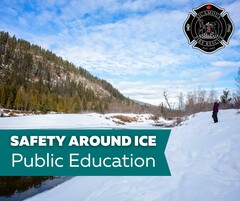Ice Safety Education & Resources
Posted On: Feb 11, 2025
Tags: Featured , Home Featured - Secondary , Live Here , Your Municipality

Winter activities like ice skating, ice fishing, and snowmobiling often involve traveling on frozen lakes and rivers. However, ice conditions are constantly changing due to weather and water movement, making them unpredictable—even when tested for thickness. Every year, one in 12 drowning victims in Canada falls through the ice.
The Lifesaving Society of BC & Yukon strongly recommends avoiding frozen bodies of water altogether. If you choose to go onto the ice, follow these essential safety guidelines:
- Check conditions before heading out. Avoid ice-related activities during warm or stormy weather. Always check ice thickness and local advisories from knowledgeable sources, such as resort owners, law enforcement or snowmobile clubs.
- Follow ice thickness recommendations. The Lifesaving Society advises a minimum ice thickness of 10 centimetres (4 inches) for a single person to walk, ice fish or cross-country ski under ideal conditions. However, ice strength can vary.
- Avoid traveling on ice alone. A buddy can assist in an emergency or go for help if needed.
- Stay off unfamiliar paths and avoid nighttime travel. Darkness reduces visibility and increases risk.
- Use extreme caution with vehicles. Avoid driving on ice whenever possible. If you must, take safety precautions: roll down windows, unlock doors, remove seat belts and turn on lights to allow for a quicker escape if the ice breaks.
- Dress for survival. A thermal protection suit improves survival chances if you fall through the ice. If unavailable, wear a lifejacket or PFD over winter clothing.
- Keep children within arm’s reach. If kids play on or near ice, they should always wear a lifejacket or thermal protection suit and be under constant adult supervision.
Fire Chief De Arcangelis recommends that anyone spending time near ice should assemble a personal safety kit that includes a lighter, waterproof matches, magnesium fire starter, pocketknife and whistle. Ice picks, an ice staff and a rope are also advisable.
To learn more, please view the Lifesaving Society of BC and Yukon's Ice Safety webpage.